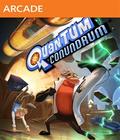At one point in Quantum Conundrum, Professor Quadrangle (who serves as the narrator) states, "These hallways are all starting to look the same to me." It's a throwaway line from the script, but after playing for a while, the comment is oddly appropriate. It describes Quantum Conundrum to a T. This is a game that has a few really great ideas but isn't quite sure how to best use them.
Advertised as the "next big thing" from Portal creator Kim Swift, Quantum Conundrum is a first-person puzzle game. Your goal is to navigate your crazy uncle's mansion, get to his lab and save the old coot from himself. It won't be as easy as it sounds, though, due to your uncle's dimensional experiments. He's managed to create a dimensional "shifter" that allows the user to swap between the fluffy, heavy, slow and antigravity dimensions. You'll need to use all of these in order to make it through the mansion alive.
The one catch to the shifting dimensions is that you can only be in a single one at any given time. While items in the heavy dimension may be strong enough to stop laser beams, they're also too heavy to hold. Switching to the fluffy dimension means you can pick up those heavy items, but they're now easily destroyed. As a result, simple solutions such as "pick up item, place in front of hazard" are not available to you. Instead, the game forces you to use momentum as a tool in many of the puzzles.
Going back to the example, you can use the fluffy dimension to pick up a safe and throw it at a laser beam. Immediately after throwing, you can switch to the heavy dimension. Since the shifts are instantaneous, the safe will harden in mid-air. Assuming your aim was true, when the now-fortified safe lands, it will safely block the laser beam. Because objects don't lose momentum unless they hit something else, you can use them as a form of travel. Pick up an item in fluffy and toss it. Switch to slow and jump on it. Then, alternate between antigravity and normal gravity until you get where you want to go.
Initially, you only have access to the fluffy dimension, but as the game progresses, the remaining four dimensions are slowly made available. However, just because you've discovered a dimension doesn't mean you always have access to it. Many puzzles purposefully limit the dimensions you can use, requiring you to first locate dimensional batteries and insert them into the proper machine before the corresponding dimension can be accessed.
On a macro level, these mechanics work nicely, and the puzzles are enjoyable to work out, if a bit simplistic at times. Where Quantum Conundrum stumbles is in the integration of twitch-based platform elements. These sections of the game aren't everywhere, but they are common enough to be mildly annoying. The most common incarnation is as a series of platforms over a bottomless pit. If you don't make precisely timed jumps, it means instant death.
If the deaths in question were simply due to an error in solving the puzzle, there would be no issue. Sadly, that's not the case. The majority of the time, you know exactly what needs to be done. The trick is just doing it. Often, sticking a jump feels like you're fighting with the controls. A hair too much in either direction, and it's retry time. Given that you don't cast a shadow (and there is no third-person option), it can be difficult to estimate a landing location. When you finally do pass the trouble spots, it ends up feeling more like luck than a real accomplishment.
Going back to Professor Quadrangle's quote, Quantum Conundrum also suffers from a serious lack of interior design. Flat colors, repetitive objects and a multitude of reused rooms abound. There is some minor variation near the end of the game when metal wall panels are introduced, but in general, the early stages look a lot like the end stages. When playing, there is no real sense of visual progression. Instead, it just feels like you're playing one generic room after another.
On a positive note, the voice acting in the game is to be commended. Quantum Conundrum may not have a complex story, but it is relayed perfectly by John de Lancie. Best known for his role as Q in "Star Trek: The Next Generation," de Lancie brings the perfect mix of concern and condescension to the role Professor Quadrangle. He is easily the best part of the whole experience.
Taken in small doses, any given level in Quantum Conundrum can be a fun diversion. As a whole, it fails to become more than a sum of its parts. The concept may be inspired and ambitious, but the repetitive puzzle rooms and twitchy platform controls make Quantum Conundrum feel rough around the edges.
Score: 6.5/10
More articles about Quantum Conundrum











 Quantum Conundrum is a multidimensional puzzle game where you manipulate your surroundings with the Interdimensional Shift Device (a glove) in order to find your uncle, an inventor who is lost in another dimension.
Quantum Conundrum is a multidimensional puzzle game where you manipulate your surroundings with the Interdimensional Shift Device (a glove) in order to find your uncle, an inventor who is lost in another dimension.

































